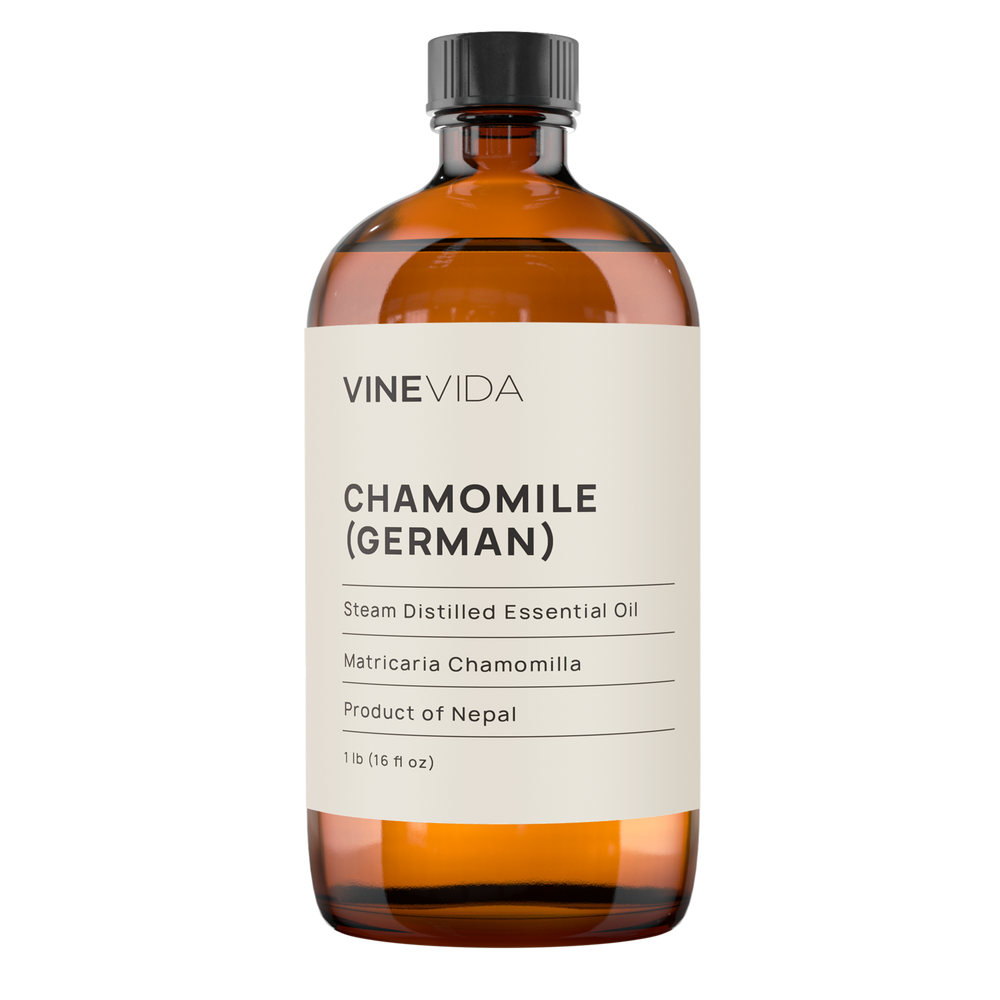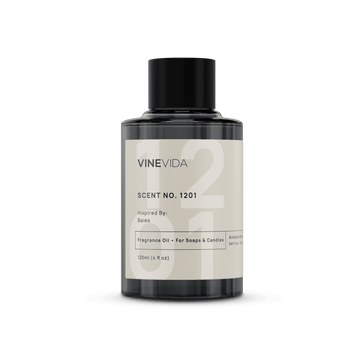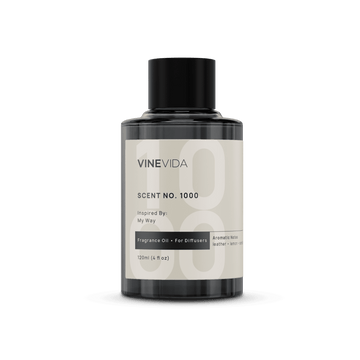I was astonished when I did an audit of which oils I hadn’t covered yet, to find I’d not talked about the Chamomiles. Some of my favorite oils! They were so calming and soothing, and were great teachers about letting go. Let’s put that right today and talk about how to use Chamomile essential oil.
What is Chamomile Essential Oil?
Well, there’s a question because it’s not straightforward.
There are four interlinked oils to think about here. Two are Chamomiles; two are not. Of the four oils, three act like Chamomile.
At Vinevida, we stock Roman and German Chamomiles (blue Chamomile). The other two to consider are Moroccan Chamomile and Blue Tansy.
Moroccan Chamomile or Chamomile Maroc is not a Chamomile. Its Latin name is Ormenis multicaulis. It's not a Chamomile at all, but it does act like one..
People often confuse Moroccan Chamomile with Blue Tansy. Blue tansy (Tanacetum annuum) is also known as blue Moroccan Chamomile, which is unlike Chamomile.
To make it even more complicated, I learned the spelling of Chamomile, as Chamomile with an H, so that I may go auto-drive on that. If I do, I apologize for that, and to let you know that, yes…they are the same.
Chamomiles are an extremely valuable crop, with the yearly market value increasing by 10%. The value of Chamomile essential oils is predicted to reach $412 million per annum by 2025.
The Physician Plant
There are very few essential oils that you must have, but I do say it about Chamomile. They are so gentle with such a wide range of well-documented properties, but that’s not why Chamomile is called the physician plant.
The botanical is generous to other plants and often supports their growth. In permaculture, adding Chamomiles into your planting fortifies surrounding species. It’s a great way to be kind to a plant that seems to be ailing. Often, planting Chamomiles around other plants nurses them back to health.
Weird and wonderful, right?
Botany of Chamomiles
Botanical Description of German Chamomile
If we return to the Roman and German Chamomiles that Vinevida stock, you may ask why their Latin names are different again. Anthemis nobilis and Matricaria recutita, respectively, would be excellent questions. It is explained through botany.
Both belong to the Asteraceae family, which is the daisy family.
This belongs to a bigger group, "Compositae," including sunflowers.
This is an important plant to pollinators because, despite its appearance of being one flower, each flower is simultaneously many. Each petal is a flower in its own right, and the corona, in the middle, comprises hundreds of tiny individual flowers. Chamomiles are rich with pollen and give generous amounts of nectar in the autumn when there are few other flowers for the bees to feed.
Asteraceae then split into subgroups called genera.
German Chamomile is a Matricaria genus member comprising approximately 130 different species. Roman Chamomile comes from the Chamaemelum genus, so sometimes you will see the Latin name written as Chamaemelum nobile.
German Chamomile is an annual that is easily grown from seed. It flowers more frequently than Roman Chamomile and will quickly replace flowers picked or lost, meaning they are great for cutting flowers or making tea. Also great for hungry bees. Pick your flowers, and there is an endless supply.
German Chamomile has an upright growth style and typically reaches about 2 feet tall with low-growing branches and fern-like, light leaves. German Chamomile flowers look almost like they are going over; the yellow center is conelike, and the petals fold slightly back.
German Chamomile flowers grow one to a stem.
I am sure you’ll have heard of Chamomile lawns popular at the end of the nineteenth century in England, but this is yet another Chamomile again, usually a species called Treneague. However, Roman Chamomile can also be used to make a lawn, which I will describe later. However, German Chamomile is delicate and easily broken, so it is best suited to flower borders.
So, where German Chamomiles have cone-shaped centers to their flowers, the sun discs on Roman Chamomiles are flat. Its flowers are bigger and have several flowers on hairy stems.
Botanical Description of Roman Chamomile
Roman Chamomile stops growing about a foot high and spreads across the ground like a thick carpet. Trenegue lawns were very popular because they were just green surfaces, but a Roman Chamomile lawn is covered with flowers, wonderfully pretty, and perfect for insects.
Shakespeare commented on the fragility of the Treneague lawn:
“Though the Chamomile, the more it is trodden on the faster it grows, [yet] youth, the more it is wasted, the sooner it wears.” - William Shakespeare, Henry IV Part
Roman Chamomile is robust and can happily be trodden on.
Lastly, Matricaria is an annual, whereas Roman is a perennial plant returning yearly.
That said, since German Chamomile self-seeds so readily, it can easily be mistaken for a perennial.
German Chamomile is stronger and slightly less bitter than tea if you want a more fragranced plant for your garden.
Understanding Chamomile Essential Oil
German Chamomile Essential Oil
Or blue Chamomile, or Chamomile matricaria…
Because it is a blue oil.
So that’s interesting because what does a Chamomile plant look like?
Green feathery leaves, daisy-like flowers, white petals, and yellow coronas….
So where’s the blue?
Azulene: Chamomiles (and yarrow) contain azulenes that turn blue when distilled because heat activates and reveals them. I was lucky enough to be invited to a distillery in Bulgaria, where I watched it happen. It was completely enchanting; this royal blue liquid formed before my eyes.
So, in this oil, the azulenes are specific to Chamomile, so they are chamazulenes.
Azulenes act like a liquid anesthetic. If the skin is sore or itchy, chamazulene feels cooling and numbing.
German Chamomile essential oil is anti-inflammatory, but this numbing action is its primary benefit.
The interesting thing about German Chamomile is that it is so well studied that restrictions have been removed about what we can say about it in Europe. German Chamomile is sold as a “drug” for teething problems and skin eruptions such as eczema.
As far as I know, though, FDA restrictions are still in place.
That it is German is a misnomer…sort of. Thousands of tons are exported to Germany from across the rest of Europe to be distilled. Consequently, our German Chamomile is from Hungary because that’s where the flowers grow. The Germans call it alles zutraut, which translates to “capable of anything.”
Interestingly, while this Matricaria has been a popular crop in India for around 200 years, this blue oil is hardly used in their medicine. (Singh, 2011) They use it for tinctures and tea; their main oil is Roman Chamomile.
Chamomile Matricaria contains three important ingredients:
Chamazulene: For its anti-inflammatory and anesthetic qualities.
Alpha bisabolol is an anti-inflammatory, but this one also has antimicrobial and anti-irritant properties.
Apigenin: This component means that Chamomile will dye things yellow, but it is also very sedative and helpful if you are struggling to sleep.
Of course, apigenin is also found in Chamomile tea, partly explaining why over a million cups of Chamomile tea are drunk daily.
Actions of German Chamomile Essential Oil
German Chamomile essential oil is reputed to be anti-inflammatory, antispasmodic, antimicrobial, antiseptic (mild), analgesic, calmative, carminative, choleretic (stimulates the liver to make bile), cholagogic (stimulates bile flow), digestive stimulant, stomachic, and sedative.
Roman Chamomile Essential Oil
Now, this oil looks and smells different. This is the prettier scented oil that is influenced by the Latin name chamomilla. It comes from the Greek chamos, meaning ground, and melos, meaning apple, because it smells apple-y and likes to remain close to the ground.
German Chamomile could be sweeter.
It is clear to slightly yellow and is much thinner in consistency than German Chamomile. So if you buy a new bottle, note that the drops speed out at a great rate of knots, not that that matters, because it's such a gentle oil, it won't spoil your blend. However, it could be quite a costly error.
So, because it’s clear, we know there are no azulenes, so it does not have the numbing action.
This time, the magic is anti-inflammatory.
Roman Chamomile essential oil is composed mainly of esters. Esters are skin healing, antimicrobial, anti-inflammatory, antispasmodic, and calming.
Angelic and tiglic ester comprise over 80% of its composition, with isobutyl angelate, pinocarvone, chamazulene, and other minor constituents. Maybe that’s why it feels so heavenly.
Also Read: Blending With Roman Chamomile
Actions of Roman Chamomile Essential Oil
It is an anti-inflammatory, antispasmodic, calmative, analgesic, anti-allergen, anticonvulsant, antiemetic, carminative, digestive stimulant, stomachic, anti-neuralgic, anti-rheumatic, and anti-bacterial.
Historical Use of Chamomile
Egyptians
The ancient Egyptians considered Chamomile a gift the gods gave and a common decoration in tombs. A pair of sandals was found in Tutankhamun’s tomb, decorated with daisy-like flowers. Perhaps because Compositeae plants look like suns, the flower offerings were made to the all-powerful sun god Ra.
Babylonians
As you’ll have gathered by now, I have bees. Each spring, I repaint their hives, so each colony knows where it lives (this reportedly reduces the spread of disease). We have four hives currently, with three colonies, so the spare is being readied to move a colony into so they can all be renovated.
The Babylonian goddess Ishtar was a bee goddess, so the Ishtar hive is decorated with the flower wall from the Ishtar Gate. I have to paint hundreds of lovely flowers...But I always bottle it before the lions!
Anglo Saxon
The British Museum has a tenth-century herbal that speaks of nice sacred herbs that the Germanic god Woden gave to the Anglo-Saxons. The Lacnunga (remedies) manuscript refers to it as May-weed. Mayweed is German Chamomile. (I wonder if the Woden association might also be why it's called German Chamomile?
The prevailing beliefs of the time were that poisons were “flying venom” spread by gusts of wind. So consuming or imbibing these sacred herbs protected people from infection.
A worm came creeping; he tore a man asunder. Then he took Woden's nine magic twigs and smote the serpent that he flew into nine bits.
Now, these nine herbs have power, against the nine magic outcasts, against nine venoms, against nine flying things, and against the loathed things that overland roam.
Then, after listing venoms of every color of the rainbow.
The nice herbs are listed as Nettle, Fennel, Crab Apple, Mugwort, Plantain, Watercress, Chervil, and either Cockspur Grass or Betony and Chamomile Matricaria.
So these venoms? What were they in the name of all that is good and pure?
Lots of different things but from the point of view of Chamomile - digestive issues.
All Chamomiles soothe the gastrointestinal system, relieve nausea, indigestion, and heartburn, and alleviate flatulence.
Oh, and venomous demons invading fallen women….
Or painful periods!
Medieval
Culpepper described Chamomile extensively:
It is so well known everywhere that it is but lost time and labor to describe it. The virtues thereof are as follows.
A decoction made of Chamomile, and drunk, takes away all pains and stitches in the side. The flowers of Chamomile beaten, and made up into balls with Gill, drive away all sorts of agues if the part grieved be anointed with that oil, taken from the flowers, from the crown of the head to the sole, and afterward laid to sweat in his bed, and that he sweats well. This is Nechessor, an Egyptian medicine.
It is profitable for all sorts of agues from phlegm, melancholy, or inflammation of the bowels, which are applied when the humor causing them shall be concocted. Nothing is more profitable to the sides and region of the liver and spleen than it. Bathing with a decoction of Chamomile removes weariness and eases pains to whatever body part soever they are applied. It comforts the sinews that are over-strained and mollifies all swellings:
It moderately comforts all parts that require warmth, digests and dissolves whatsoever has need thereof, by a wonderful speedy property. It eases all pains of the cholic and stone and all pains and torments of the belly and gently provokes urine. The flowers boiled in posset-drink provoke sweat, help to expel all colds, aches, and pains, and are an excellent help to bring down women’s courses.
Syrup made of the juice of Chamomile, with the flowers, in white wine, is a remedy against jaundice and dropsy. The flowers boiled in lye are good to wash the head and comfort it and the brain. The oil made of the Chamomile flowers is much used against all hard swellings, pains or aches, shrinking of the sinews, cramps, pains in the joints, or any other part of the body. Being used in clysters, it helps to dissolve the wind and pains in the belly; anointed also, it helps with stitches and pains in the sides.
Nechessor saith the Egyptians dedicated it to the Sun because it cured agues, and they were like enough to do it, for they were the arrantest apes in their religion that I ever read of. Bachinus, Bena, and Lobel commend the syrup made of the juice of it and sugar, taken inwardly, to be excellent for the spleen. Also, this is certain that it most wonderfully breaks the stone: Some take it in syrup or decoction, and others inject the juice of it into the bladder with a syringe. My opinion is that the salt of it, taken half a dram in the morning in a little white or Rhenish wine, is better than either; that it is excellent for the stone, appears in this which I have seen tried, viz., A stone that has been taken out of the body of a man being wrapped in Chamomile will eventually dissolve, and in a little time too.
Please do not inject people’s bladders with Chamomile!
Ruled By The Sun
What Culpepper says of Chamomile being of the Sun is interesting and helpful since Western herbalism all went by planetary prescriptions before the eighteenth century.
Medicines of the Sun are fortifying and strengthening, but they also speak to the conscious mind. My very favorite description of this comes from a herbalist called Dale Pendell.
He writes:
“The sun doctor moves easily through the world, unperturbed, seemingly able to open doors anywhere she wishes. A life filled with routines and good health, with attention to detail and reliability, the sun doctor knows where she stands.”
“The moon doctor does not need ground. … The moon doctor rides dragons and knows the way through hell. The sun doctor knows how to stay out of hell, and does. To the sun doctor, every day is unique, every day happens for the first time. To the moon doctor, there are no days. He lives in one instant only, eternally preparing the lunar medicine.”
This is a great analogy of what a Chamomile is like.
It’s a very perky medicine.
I always say I can hear it sing, “Que sera sera, whatever will be will be.” It’s hopeful, curious, and happy to go with the flow.
Sun medicine speaks to order, logic, ease of thinking, and decision-making in the conscious mind. Conscious thoughts as opposed to the ones that creep in on the dragon's back.
It is clear, objective, and steady. The word that most defines sun medicine is rational. This would be helpful to someone anxious.
Mind-Body Connection
And we should think of the mind-body-spirit connection, first and foremost, with Chamomiles.
- My eczema has flared because I’m stressed.
- I’m so worried about tomorrow. I’ve been on and off the loo all night.
- That’s annoyed me so much; I can feel all the tension in my back.
Yes, Chamomile treats all outward physical manifestations, but perhaps more importantly, it says, “Just let go. Release your grip, and you’ll feel so much better.”
Chamomiles have very thin stems and are so strong bobbing in the breeze.
It’s their flexibility that’s their strength.
Also Read: Roman Chamomile Metaphysical
German Chamomile Essential Oil Vs. Roman Chamomile Essential Oil
So how do you know which one to choose?
Hmmmm. Let’s think….
Skin
If itchy or sore skin is broken from eczema, I will go German.
The same applies to skincare for sensitive skin.
Joints
Where we are talking about inflammation in terms of being swollen rather than red, I’d opt for Roman Chamomile.
Digestive
I would go to Rome again.
Genito-urinary
I’d be more inclined to choose German.
Children
I’d always go with German Chamomile. The chamazulene is lovely for sore bums and colic alike. It’s gentler, but if you only have Roman Chamomile, go with it; there’s no reason not to.
Acute or Chronic Conditions
One more factor I always consider with Chamomiles is the doctrine of signatures. One is annual; one is perennial. I see that as a signature to choose German Chamomile for acute breakouts that are just off a flare-up. I use Roman Chamomile essential oil for more chronic issues that keep coming back.
However, that’s just personal preference, and the two are interchangeable. The only real advantage I see is how German Chamomile essential oil numbs, so I choose it for sunburn, stings, and toothache.
Safety:
The maximum dilution of both Chamomile Matricaria and Roman Chamomile is 3%.
For children under 6, reduce to 1%.
Both German Chamomile and Roman Chamomile should be avoided in the first 16 weeks of pregnancy.
Importantly, both species are related to ragweed, so if you are allergic to ragweed, you shouldn’t drink chamomile tea made from either kind of Chamomile or use either Chamomile essential oil.
Conclusion
Both our chamomile essential oils, Roman Chamomile essential oil and German Chamomile essential oil, are safe and gentle ways to calm and soothe. They work on the emotional and physical bodies to soothe and calm the system.
Also Read: Nature’s Most Soothing Gift: Roman Chamomile Essential Oil
















